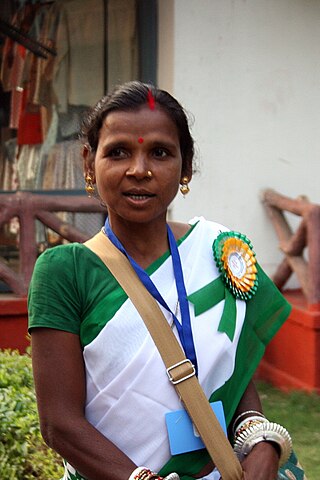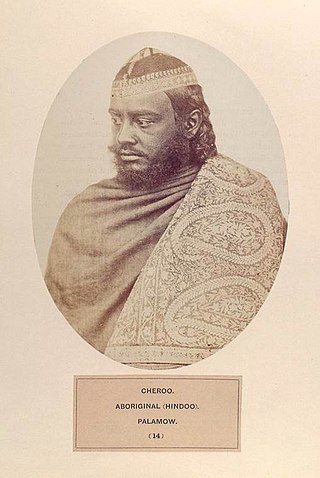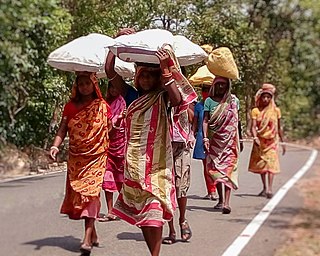Related Research Articles

Santali, also known as Santal or Santhali, is the most widely-spoken language of the Munda subfamily of the Austroasiatic languages, related to Ho and Mundari, spoken mainly in the Indian states of Assam, Bihar, Jharkhand, Mizoram, Odisha, Tripura and West Bengal by Santals. It is a recognised regional language of India per the Eighth Schedule of the Indian Constitution. It is spoken by around 7.6 million people in India, Bangladesh, Bhutan and Nepal, making it the third most-spoken Austroasiatic language after Vietnamese and Khmer.

The Munda people are an Austroasiatic-speaking ethnic group of the Indian subcontinent. They speak Mundari as their native language, which belongs to the Munda subgroup of Austroasiatic languages. The Munda are found mainly concentrated in the south and East Chhotanagpur Plateau region of Jharkhand, Odisha and West Bengal. The Munda also reside in adjacent areas of Madhya Pradesh as well as in portions of Bangladesh, Nepal, and the state of Tripura. They are one of India's largest scheduled tribes. Munda people in Tripura are also known as Mura.
The tribes of Jharkhand consist of 32 scheduled tribes inhabiting the Jharkhand state in India. In 1872, only 18 tribes were counted among the scheduled tribes from which Banjara, Bhatudi, Chik Baraik, and Mahli were marked as semi-Hindu aboriginal and Kora as proletariat Hindu. In the 1931 census, including the above four semi-Hindu aboriginal and Kora, a proletariat Hindu, the number was raised to 26 from 18. They were Birajia, Godait, Karmali and Paharia, but Kisan was excluded from the list. In the 1941 census, Baga, Bedia and Lohra were included again taking Kisan in the annexure and the number came to 30 which prevailed till June 2003. Kanwar and Kol were added on 8 June 2003 in the annexure and the number of Schedule Tribes came to 32.

The Korwa people are a Munda, a Scheduled Tribe ethnic group of India. They live mainly on the border between Chhattisgarh and Jharkhand. A small number of Korwa are also found in the Mirzapur district of Uttar Pradesh.

The Ho people are an Austroasiatic Munda ethnic group of India. They are mostly concentrated in the Kolhan region of Jharkhand and northern Odisha where they constitute around 10.7% and 7.3% of the total Scheduled Tribe population respectively, as of 2011. With a population of approximately 700,000 in the state in 2001, the Ho are the fourth most numerous Scheduled tribe in Jharkhand after the Santals, Kurukhs, and Mundas. Ho also inhabit adjacent areas in the neighbouring states of Odisha, West Bengal and Bihar bringing the total to 806,921 as of 2001. They also live in Bangladesh and Nepal.

Khunti district is one of the twenty-four districts in South Chotanagpur division of the Indian state of Jharkhand. The district of Khunti was carved out of Ranchi district on 12 September 2007. As of 2011, it is the second least populous district of Jharkhand, after Lohardaga. Khunti town is the headquarters of the district. It is historically known as the birthplace of Birsa Munda, and being the centre of activity of the Birsa movement. It is the part of State Capital Region (SCR).
Chik Baraik or Baraik are a tribal community originally from the Chota Nagpur plateau and neighbouring states of Chhattisgarh, and Odisha.

Bhumij is a Munda ethnic group of India. They primarily live in the Indian states of West Bengal, Odisha, Assam and Jharkhand, mostly in the old Singhbhum district. Also in states like Bihar and Assam. There is also a sizeable population found in Bangladesh. Bhumijas speak the Bhumij language, an Austroasiatic language, and use Ol Onal script for writing.

The Chero is a caste found in the states of Bihar, Jharkhand and Uttar Pradesh in India.
The Sauria Paharia people are a Dravidian ethnic people of Bangladesh and the Indian states of Jharkhand, West Bengal, and Bihar. They are found mostly in Santhal Parganas region in the Rajmahal Hills.
The Bedia are a community in India. They believe that they originally lived on Mohdipahar of Hazaribagh district and have descended from the union of Vedbansi prince with a Munda girl. A legend has heard that they had their own 'Vedas' and hence it is called Bediya. Their Veda was different from the Vedas of Aryans, which were destroyed by the Aryans

The Bhuiyan or Bhuiya are an indigenous community found in the Indian states of Bihar, Jharkhand, Madhya Pradesh, Odisha, Uttar Pradesh and West Bengal. They are not only geographically disparate but also have many cultural variations and subgroups.

Sarnaism is a religious faith of the Indian subcontinent, predominantly followed by indigenous communities in the Chota Nagpur Plateau region across states like Jharkhand, Odisha, West Bengal, Bihar, and Chhattisgarh.
Ghasi is a caste found in Jharkhand, Chhattisgarh, Odisha and West Bengal. They are traditionally caretakers of horses and village musicians. They are known as Ghasiya in Uttar Pradesh.
The Nagpuria people, also Nagpuri or Sadan, are an Indo-Aryan speaking ethnolinguistic group who are the native speakers of the Nagpuri language and natives of the western Chota Nagpur Plateau region of Indian states of Jharkhand, Bihar, Chhattisgarh and Odisha.
Sadan are the native Indo-Aryan-speaking ethnolinguistic groups of Chota Nagpur Plateau consist of Indian state of Jharkhand and neighbouring states who speak Nagpuri, Khortha and Kurmali language as their native language.
The Kora are an ethnic group found in the Indian states of West Bengal, Odisha and Jharkhand and the Bangladeshi division of Rajshahi. The 2011 census showed their population to be around 260,000. They are classified as a Scheduled Tribe by the Indian government.

Bagal is a cattle herding caste of East India. Bagal people are living in the state of West Bengal, Jharkhand and Odisha. They use Kudmali/ Manbhumi dialect of Bengali as mother tongue and use Bengali, Hindi and Odia language to communicate with the society.
Rajwars or Rajuar is a shifting cultivation community. The people of this community mainly live in Bihar, Jharkhand, Madhya Pradesh, Odisha and West Bengal. In Odisha, they are recognized as a Scheduled Tribe, while in Bihar, Jharkhand, and West Bengal, they are classified as Scheduled Caste. In other states, the community is considered part of the Other Backward Classes (OBC) or general population.
References
- ↑ "Census of India Website : Office of the Registrar General & Census Commissioner, India". www.censusindia.gov.in. Retrieved 3 November 2017.
- ↑ "The Constitution (Scheduled tribes) Order, 1950" (PDF). Ministry of Law and Justice, Government of India. pp. 173, 182. Archived from the original (PDF) on 27 January 2018. Retrieved 11 March 2009.
- ↑ Pant, Niranjan; Verma, R. K. (2010). Tanks in Eastern India: A Study in Exploration. ISBN 9789290907312.
- ↑ Ota, A.B. (2014). Mahali (PDF).
{{cite book}}:|website=ignored (help) - ↑ "Mahali". ethnologue.
- ↑ The tribes and castes of the Central Provinces of India. London: Macmillan and Co. 1916.
 This article incorporates text from this source, which is in the public domain .
This article incorporates text from this source, which is in the public domain . - ↑ Pranab Chandra Roy Choudhury (1970). Bihar District Gazetteers, Volume 12; Volume 16. Superintendent, Secretariat Press, Bihar. p. 128.
- ↑ Jewitt, Sarah (31 July 2019). Environment, Knowledge and Gender: Local Development in India's Jharkhand. Routledge. ISBN 978-1351729895 . Retrieved 4 April 2022.
- ↑ Ranjan, Manish (19 August 2002). Jharkhand Samanya Gyanand. Prabhat Prakashan. ISBN 9789351867982.
{{cite book}}:|website=ignored (help) - ↑ Shah, Alpa (2003). "An Anthropological Study of Rural Jharkhand, India" (PDF). p. 53. Retrieved 8 November 2022.
Jharkhand categorises the Mahelis along with the Oraon, Munda and Badaiks, as a Scheduled Tribe